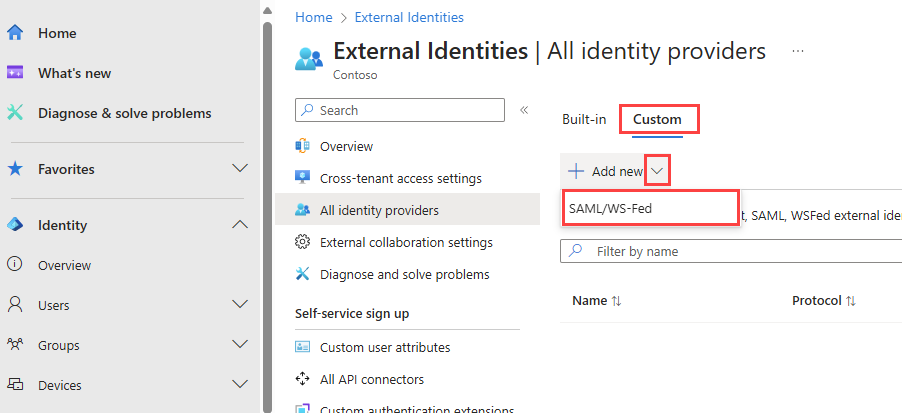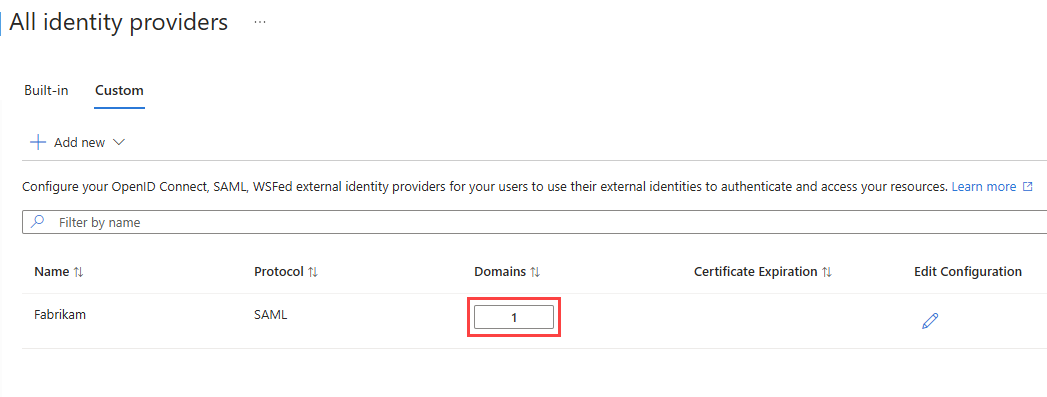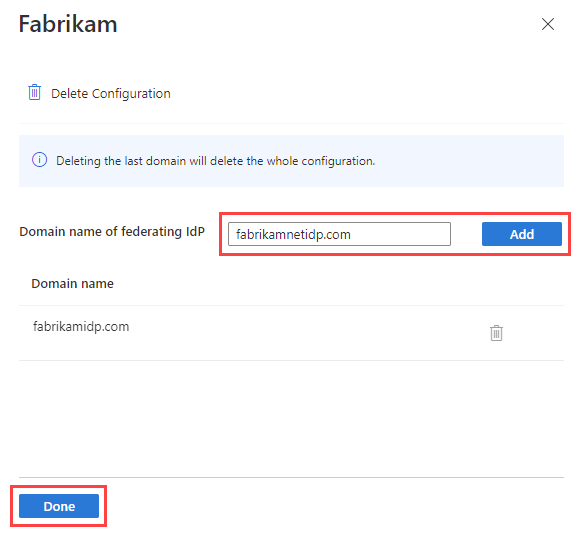Federation with SAML/WS-Fed identity providers
Applies to:  Workforce tenants
Workforce tenants  External tenants (learn more)
External tenants (learn more)
Note
Direct federation in Microsoft Entra External ID is now referred to as SAML/WS-Fed identity provider (IdP) federation.
This article describes how to set up federation with any organization whose identity provider (IdP) supports the SAML 2.0 or WS-Fed protocol. When you set up federation with a partner's IdP, new guest users from that domain can use their own IdP-managed organizational account to sign in to your Microsoft Entra tenant and start collaborating with you. There's no need for the guest user to create a separate Microsoft Entra account.
Important
- You can now set up SAML/WS-Fed IdP federation with Microsoft Entra ID verified domains. The verified domain must be in a separate tenant from where you are setting up federation. Once configured, you can make sure users sign in with the federated IdP instead of Microsoft Entra ID by configuring the invitation Redemption order in your cross-tenant access settings for inbound B2B collaboration.
- We no longer support an allowlist of IdPs for new SAML/WS-Fed IdP federations. When you're setting up a new external federation, refer to Step 1: Determine if the partner needs to update their DNS text records.
- In the SAML request sent by Microsoft Entra ID for external federations, the Issuer URL is a tenanted endpoint. For any new federations, we recommend that all our partners set the audience of the SAML or WS-Fed based IdP to a tenanted endpoint. Refer to the SAML 2.0 and WS-Fed required attributes and claims sections. Any existing federations configured with the global endpoint will continue to work, but new federations will stop working if your external IdP is expecting a global issuer URL in the SAML request.
- We've removed the single domain limitation. You can now associate multiple domains with an individual federation configuration.
- We've removed the limitation that required the authentication URL domain to match the target domain or be from an allowed IdP. For details, see Step 1: Determine if the partner needs to update their DNS text records.
When is a guest user authenticated with SAML/WS-Fed IdP federation?
After you set up federation with an organization's SAML/WS-Fed IdP:
If the domain you're federating with isn't a Microsoft Entra ID verified domain, any new guest users you invite will be authenticated using that SAML/WS-Fed IdP.
If the domain is Microsoft Entra ID verified, you also need to configure the Redemption order settings (preview) in your cross-tenant access settings for inbound B2B collaboration to prioritize redemption with the federated IdP. Then any new guest users you invited will be authenticated using that SAML/WS-Fed IdP.
It’s important to note that setting up federation doesn’t change the authentication method for guest users who have already redeemed an invitation from you. Here are some examples:
- Guest users have already redeemed invitations from you, and then later you set up federation with the organization's SAML/WS-Fed IdP. These guest users continue to use the same authentication method they used before you set up federation.
- You set up federation with an organization's SAML/WS-Fed IdP and invite guest users, and then the partner organization later moves to Microsoft Entra ID. The guest users who have already redeemed invitations continue to use the federated SAML/WS-Fed IdP, as long as the federation policy in your tenant exists.
- You delete federation with an organization's SAML/WS-Fed IdP. Any guest users currently using the SAML/WS-Fed IdP are unable to sign in.
In any of these scenarios, you can update a guest user’s authentication method by resetting their redemption status.
SAML/WS-Fed IdP federation is tied to domain namespaces, such as contoso.com and fabrikam.com. When establishing federation with AD FS or a third-party IdP, organizations associate one or more domain namespaces to these IdPs.
End-user experience
With SAML/WS-Fed IdP federation, guest users sign into your Microsoft Entra tenant using their own organizational account. When they're accessing shared resources and are prompted for sign-in, users are redirected to their IdP. After successful sign-in, users are returned to Microsoft Entra ID to access resources. If the Microsoft Entra session expires or becomes invalid and the federated IdP has SSO enabled, the user experiences SSO. If the federated user's session is valid, the user isn't prompted to sign in again. Otherwise, the user is redirected to their IdP for sign-in.
Sign-in endpoints
SAML/WS-Fed IdP federation guest users can now sign in to your multitenant or Microsoft first-party apps by using a common endpoint (in other words, a general app URL that doesn't include your tenant context). During the sign-in process, the guest user chooses Sign-in options, and then selects Sign in to an organization. The user then types the name of your organization and continues signing in using their own credentials.
SAML/WS-Fed IdP federation guest users can also use application endpoints that include your tenant information, for example:
https://myapps.microsoft.com/?tenantid=<your tenant ID>https://myapps.microsoft.com/<your verified domain>.onmicrosoft.comhttps://portal.azure.com/<your tenant ID>
You can also give guest users a direct link to an application or resource by including your tenant information, for example https://myapps.microsoft.com/signin/X/<application ID?tenantId=<your tenant ID>.
Frequently asked questions
Can I set up SAML/WS-Fed IdP federation with Microsoft Entra ID verified domains?
Yes, you can now set up SAML/WS-Fed IdP federation with other Microsoft Entra ID verified domains. This includes verified domains where the tenant has undergone an admin takeover. If the domain you're federating with is Microsoft Entra ID verified, you also need to configure the Redemption order settings (preview) in your cross-tenant access settings for inbound B2B collaboration to make sure that when invited users sign in, they redeem their invitations using the federated IdP instead of Microsoft Entra ID.
Currently, redemption order settings aren't supported across clouds. If the domain you're federating with is Microsoft Entra ID verified in a different Microsoft cloud, Microsoft Entra redemption always takes precedence.
Can I set up SAML/WS-Fed IdP federation with a domain for which an unmanaged (email-verified) tenant exists?
Yes, you can set up SAML/WS-Fed IdP federation with domains that aren't DNS-verified in Microsoft Entra ID, including unmanaged (email-verified or "viral") Microsoft Entra tenants. Such tenants are created when a user redeems a B2B invitation or performs self-service sign-up for Microsoft Entra ID using a domain that doesn’t currently exist.
Can I set up federation with multiple domains from the same tenant?
Yes, we now support SAML/WS-Fed IdP federation with multiple domains from the same tenant.
Do I need to renew the signing certificate when it expires?
If you specify the metadata URL in the IdP settings, Microsoft Entra ID automatically renews the signing certificate when it expires. However, if the certificate is rotated for any reason before the expiration time, or if you don't provide a metadata URL, Microsoft Entra ID is unable to renew it. In this case, you need to update the signing certificate manually.
If SAML/WS-Fed IdP federation and email one-time passcode authentication are both enabled, which method takes precedence?
When SAML/WS-Fed IdP federation is established with a partner organization, it takes precedence over email one-time passcode authentication for new guest users from that organization. If a guest user redeemed an invitation using one-time passcode authentication before you set up SAML/WS-Fed IdP federation, they continue to use one-time passcode authentication.
Does SAML/WS-Fed IdP federation address sign-in issues due to a partially synced tenancy?
No, the email one-time passcode feature should be used in this scenario. A “partially synced tenancy” refers to a partner Microsoft Entra tenant where on-premises user identities aren't fully synced to the cloud. A guest whose identity doesn’t yet exist in the cloud but who tries to redeem your B2B invitation isn't able to sign in. The one-time passcode feature would allow this guest to sign in. The SAML/WS-Fed IdP federation feature addresses scenarios where the guest has their own IdP-managed organizational account, but the organization has no Microsoft Entra presence at all.
Once SAML/WS-Fed IdP federation is configured with an organization, does each guest need to be sent and redeem an individual invitation?
When inviting new guests, you still need to send invitations or provide direct links so the guests can complete the redemption steps. For existing guests, you don't necessarily need to send new invitations. Existing guests will continue using the authentication method they used before federation was set up. If you want these guests to start using federation for authentication, you can reset their redemption status. Then the next time they access your app or use the link in your invitation, they'll repeat the redemption process and start using federation as their authentication method.
Is there a way to send a signed request to the SAML identity provider?
Currently, the Microsoft Entra SAML/WS-Fed federation feature doesn't support sending a signed authentication token to the SAML identity provider.
What permissions are required to configure a SAML/Ws-Fed identity provider?
You need to be at least an External Identity Provider Administrator to configure a SAML/Ws-Fed identity provider.
Does federation eliminate the need to create a guest account in my directory for the B2B collaboration user?
No. A guest account is created for a B2B collaboration user in your directory regardless of the authentication or federation method used. This user object allows you to grant access to applications, assign roles, and define membership in security groups.
Step 1: Determine if the partner needs to update their DNS text records
Depending on the partner's IdP, the partner might need to update their DNS records to enable federation with you. Use the following steps to determine if DNS updates are needed.
Note
We no longer support an allowlist of IdPs for new SAML/WS-Fed IdP federations.
Check the partner's IdP passive authentication URL to see if the domain matches the target domain or a host within the target domain. In other words, when setting up federation for
fabrikam.com:- If the passive authentication endpoint is
https://fabrikam.comorhttps://sts.fabrikam.com/adfs(a host in the same domain), no DNS changes are needed. - If the passive authentication endpoint is
https://fabrikamconglomerate.com/adfsorhttps://fabrikam.com.uk/adfs, the domain doesn't match the fabrikam.com domain, so the partner needs to add a text record for the authentication URL to their DNS configuration.
- If the passive authentication endpoint is
If DNS changes are needed based on the previous step, ask the partner to add a TXT record to their domain's DNS records, like the following example:
fabrikam.com. IN TXT DirectFedAuthUrl=https://fabrikamconglomerate.com/adfs
Step 2: Configure the partner organization’s IdP
Next, your partner organization needs to configure their IdP with the required claims and relying party trusts.
Note
To illustrate how to configure a SAML/WS-Fed IdP for federation, we’ll use Active Directory Federation Services (AD FS) as an example. See the article Configure SAML/WS-Fed IdP federation with AD FS, which gives examples of how to configure AD FS as a SAML 2.0 or WS-Fed IdP in preparation for federation.
SAML 2.0 configuration
Microsoft Entra B2B can be configured to federate with IdPs that use the SAML protocol with specific requirements listed in this section. For more information about setting up a trust between your SAML IdP and Microsoft Entra ID, see Use a SAML 2.0 Identity Provider (IdP) for SSO.
Note
You can now set up SAML/WS-Fed IdP federation with other Microsoft Entra ID verified domains. See the Frequently asked questions section for details.
Required SAML 2.0 attributes and claims
The following tables show requirements for specific attributes and claims that must be configured at the third-party IdP. To set up federation, the following attributes must be received in the SAML 2.0 response from the IdP. These attributes can be configured by linking to the online security token service XML file or by entering them manually.
Note
Ensure the value matches the cloud for which you're setting up external federation.
Required attributes for the SAML 2.0 response from the IdP:
| Attribute | Value |
|---|---|
| AssertionConsumerService | https://login.microsoftonline.com/login.srf |
| Audience | https://login.microsoftonline.com/<tenant ID>/ (Recommended) Replace <tenant ID> with the tenant ID of the Microsoft Entra tenant you're setting up federation with.In the SAML request sent by Microsoft Entra ID for external federations, the Issuer URL is a tenanted endpoint (for example, https://login.microsoftonline.com/<tenant ID>/). For any new federations, we recommend that all our partners set the audience of the SAML or WS-Fed based IdP to a tenanted endpoint. Any existing federations configured with the global endpoint (for example, urn:federation:MicrosoftOnline) will continue to work, but new federations will stop working if your external IdP is expecting a global issuer URL in the SAML request sent by Microsoft Entra ID. |
| Issuer | The issuer URI of the partner's IdP, for example http://www.example.com/exk10l6w90DHM0yi... |
Required claims for the SAML 2.0 token issued by the IdP:
| Attribute Name | Value |
|---|---|
| NameID Format | urn:oasis:names:tc:SAML:2.0:nameid-format:persistent |
http://schemas.xmlsoap.org/ws/2005/05/identity/claims/emailaddress |
emailaddress |
WS-Fed configuration
Microsoft Entra B2B can be configured to federate with IdPs that use the WS-Fed protocol. This section discusses the requirements. Currently, the two WS-Fed providers have been tested for compatibility with Microsoft Entra ID include AD FS and Shibboleth. For more information about establishing a relying party trust between a WS-Fed compliant provider with Microsoft Entra ID, see the "STS Integration Paper using WS Protocols" available in the Microsoft Entra identity Provider Compatibility Docs.
Note
You can now set up SAML/WS-Fed IdP federation with other Microsoft Entra ID verified domains. See the Frequently asked questions section for details.
Required WS-Fed attributes and claims
The following tables show requirements for specific attributes and claims that must be configured at the third-party WS-Fed IdP. To set up federation, the following attributes must be received in the WS-Fed message from the IdP. These attributes can be configured by linking to the online security token service XML file or by entering them manually.
Note
Ensure the value matches the cloud for which you're setting up external federation.
Required attributes in the WS-Fed message from the IdP:
| Attribute | Value |
|---|---|
| PassiveRequestorEndpoint | https://login.microsoftonline.com/login.srf |
| Audience | https://login.microsoftonline.com/<tenant ID>/ (Recommended) Replace <tenant ID> with the tenant ID of the Microsoft Entra tenant you're setting up federation with.In the SAML request sent by Microsoft Entra ID for external federations, the Issuer URL is a tenanted endpoint (for example, https://login.microsoftonline.com/<tenant ID>/). For any new federations, we recommend that all our partners set the audience of the SAML or WS-Fed based IdP to a tenanted endpoint. Any existing federations configured with the global endpoint (for example, urn:federation:MicrosoftOnline) will continue to work, but new federations will stop working if your external IdP is expecting a global issuer URL in the SAML request sent by Microsoft Entra ID. |
| Issuer | The issuer URI of the partner's IdP, for example http://www.example.com/exk10l6w90DHM0yi... |
Required claims for the WS-Fed token issued by the IdP:
| Attribute | Value |
|---|---|
| ImmutableID | http://schemas.microsoft.com/LiveID/Federation/2008/05/ImmutableID |
| emailaddress | http://schemas.xmlsoap.org/ws/2005/05/identity/claims/emailaddress |
Step 3: Configure SAML/WS-Fed IdP federation in Microsoft Entra ID
Next, configure federation with the IdP configured in step 1 in Microsoft Entra ID. You can use either the Microsoft Entra admin center or the Microsoft Graph API. It might take 5-10 minutes before the federation policy takes effect. During this time, don't attempt to redeem an invitation for the federation domain. The following attributes are required:
- Issuer URI of the partner's IdP
- Passive authentication endpoint of partner IdP (only https is supported)
- Certificate
To configure federation in the Microsoft Entra admin center
Tip
Steps in this article might vary slightly based on the portal you start from.
Sign in to the Microsoft Entra admin center as at least an External Identity Provider Administrator.
Browse to Identity > External Identities > All identity providers.
Select the Custom tab, and then select Add new > SAML/WS-Fed.
On the New SAML/WS-Fed IdP page, enter the following:
- Display name - Enter a name to help you identify the partner's IdP.
- Identity provider protocol - Select SAML or WS-Fed.
- Domain name of federating IdP - Enter your partner’s IdP target domain name for federation. During this initial configuration, enter just one domain name. You can add more domains later.
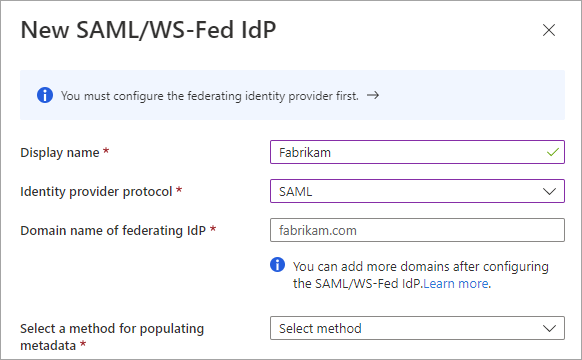
Select a method for populating metadata. If you have a file that contains the metadata, you can automatically populate the fields by selecting Parse metadata file and browsing for the file. Or, you can select Input metadata manually and enter the following information:
- The Issuer URI of the partner's SAML IdP, or the Entity ID of the partner's WS-Fed IdP.
- The Passive authentication endpoint of the partner's SAML IdP, or the Passive requestor endpoint of the partner's WS-Fed IdP.
- Certificate - The signing certificate ID.
- Metadata URL - The location of the IdP's metadata for automatic renewal of the signing certificate.
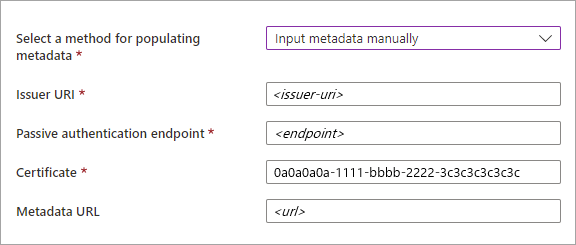
Note
Metadata URL is optional, however we strongly recommend it. If you provide the metadata URL, Microsoft Entra ID can automatically renew the signing certificate when it expires. If the certificate is rotated for any reason before the expiration time or if you do not provide a metadata URL, Microsoft Entra ID will be unable to renew it. In this case, you'll need to update the signing certificate manually.
Select Save. The identity provider is added to the SAML/WS-Fed identity providers list.
(Optional) To add more domain names to this federating identity provider:
To configure federation using the Microsoft Graph API
You can use the Microsoft Graph API samlOrWsFedExternalDomainFederation resource type to set up federation with an identity provider that supports either the SAML or WS-Fed protocol.
Step 4: Configure the redemption order for Microsoft Entra ID verified domains
If the domain is Microsoft Entra ID verified, configure the Redemption order settings in your cross-tenant access settings for inbound B2B collaboration. Move SAML/WS-Fed identity providers to the top of the Primary identity providers list to prioritize redemption with the federated IdP.
Note
The Microsoft Entra admin center settings for the configurable redemption feature are currently rolling out to customers. Until the settings are available in the admin center, you can configure the invitation redemption order using the Microsoft Graph REST API (beta version). See Example 2: Update default invitation redemption configuration in the Microsoft Graph reference documentation.
Step 5: Test SAML/WS-Fed IdP federation in Microsoft Entra ID
Now test your federation setup by inviting a new B2B guest user. For details, see Add Microsoft Entra B2B collaboration users in the Microsoft Entra admin center.
How do I update the certificate or configuration details?
On the All identity providers page, you can view the list of SAML/WS-Fed identity providers you've configured and their certificate expiration dates. From this list, you can renew certificates and modify other configuration details.
Sign in to the Microsoft Entra admin center as at least an External Identity Provider Administrator.
Browse to Identity > External Identities > All identity providers.
Select the Custom tab.
Scroll to an identity provider in the list or use the search box.
To update the certificate or modify configuration details:
- In the Configuration column for the identity provider, select the Edit link.
- On the configuration page, modify any of the following details:
- Display name - Display name for the partner's organization.
- Identity provider protocol - Select SAML or WS-Fed.
- Passive authentication endpoint - The partner IdP's passive requestor endpoint.
- Certificate - The ID of the signing certificate. To renew it, enter a new certificate ID.
- Metadata URL - The URL containing the partner's metadata, used for automatic renewal of the signing certificate.
- Select Save.
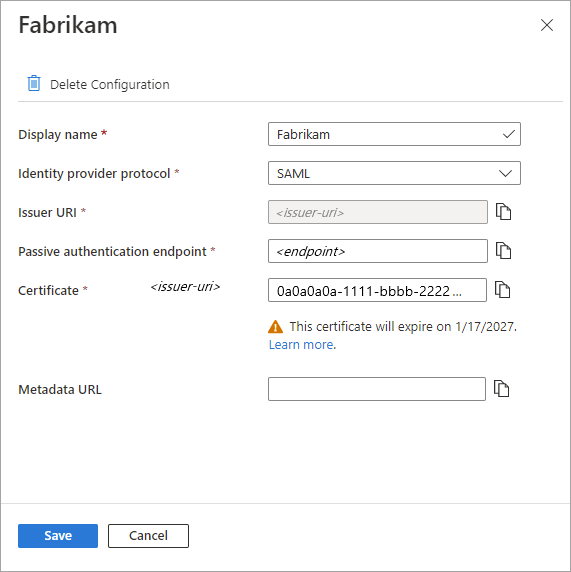
To edit the domains associated with the partner, select the link in the Domains column. In the domain details pane:
- To add a domain, type the domain name next to Domain name of federating IdP, and then select Add. Repeat for each domain you want to add.
- To delete a domain, select the delete icon next to the domain.
- When you're finished, select Done.
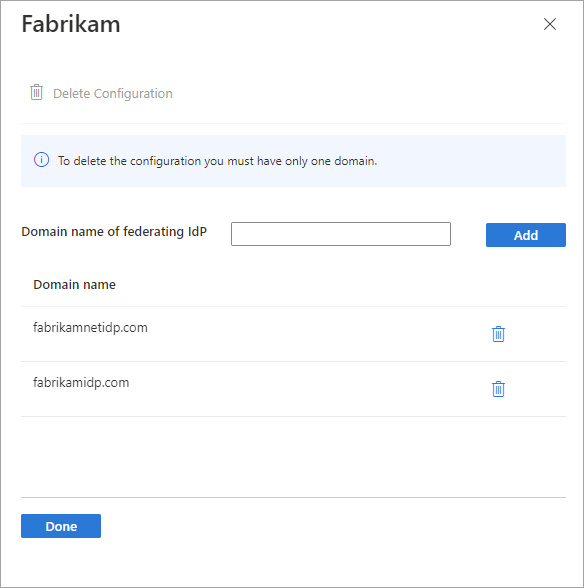
Note
To remove federation with the partner, delete all but one of the domains and follow the steps in the next section.
How do I remove federation?
You can remove your federation configuration. If you do, federation guest users who have already redeemed their invitations can no longer sign in. But you can give them access to your resources again by resetting their redemption status. To remove a configuration for an IdP in the Microsoft Entra admin center:
Sign in to the Microsoft Entra admin center as at least an External Identity Provider Administrator.
Browse to Identity > External Identities > All identity providers.
Select the Custom tab, and then scroll to the identity provider in the list or use the search box.
Select the link in the Domains column to view the IdP's domain details.
Delete all but one of the domains in the Domain name list.
Select Delete Configuration, and then select Done.
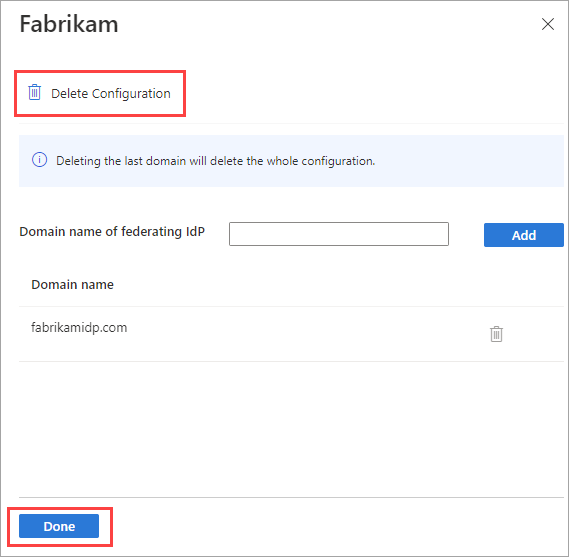
Select OK to confirm deletion.
You can also remove federation using the Microsoft Graph API samlOrWsFedExternalDomainFederation resource type.
Next steps
Learn more about the invitation redemption experience when external users sign in with various identity providers.
